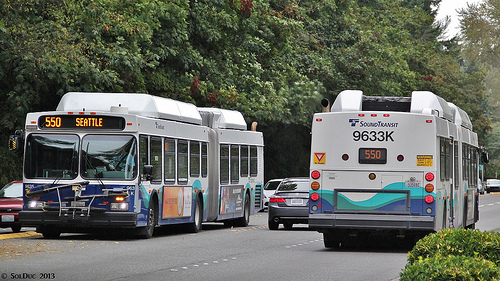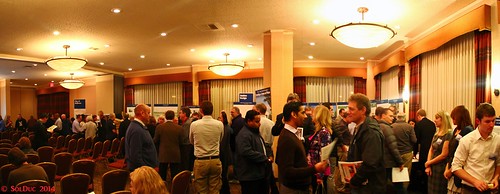
During the month of February, Sound Transit held two open houses about East Link Light Rail project. The first open house discussed the South Bellevue segment while the second discussed the East Main Station.
South Bellevue Open House
South Bellevue’s northbound bus issue was solved. The previous design required northbound buses to do eight—that’s right, eight—90-degree turns to get to the station. Many people pointed out this flaw at the 30% design open house. Now, northbound buses will stick to the current routing, while the northbound platform will be used for paratransit. Sound Transit staff provided information regarding the layover area and what it is going to be used for. Essentially, the layover area could be used as extra capacity for buses that currently layover in downtown Bellevue if space becomes sparse there, except route 554 which would either be truncated at Mercer Island or not at all. One of the main issues was the lack of an HOV on-ramp to/from Eastbound I-90.
The capacity of East Link will be huge. Sound Transit is planning to start with 3-car trains every 7 minutes during peak, making capacity of the line slightly above 5,000 people per hour per direction (pphd). As ridership increases, the next move will be to put 4-car trains every 8 minutes, making pphd 6,000, or as much as I-90 carries (around 2,000 pphd per lane or 6,000 total). Sound Transit puts the maximum capacity of the line at 12,000 pphd. That would mean 4-minute headways, which would be quite a feature, but is fully possible in the DSTT and most likely in the short at-grade section in Bel-Red.
There will be a total of five crossover tracks between I-90 and Overlake: near South Bellevue Station, East Main Station, Downtown Bellevue Station, Overlake, and one between the 120th and 130th Stations. Overlake Station’s design will use crossover track type as at Westlake and Sea-Tac. Trains will be able to either cross tracks just before the station as at Sea-Tac, but if needed they’re building a second crossover just after the station, most likely along with a pocket track.
Concerns from the public included light pollution around the station, security and the retained cut in front of the Winters House. Residents were reassured by Sound Transit staff about the first two issues. The Winters House was the subject of much commentary, with some happy that it was being protected and others complaining that it wasn’t historic enough to be worth a multi-million dollar retained cut and lid.
Finally, a group named Better Bellevue was handing out flyers trying to get people to fight against the current light rail alignment, advocating for a bored tunnel all the way from South Bellevue to Downtown. They argued that the project was equal to North Seattle, which is getting a tunnel. The comparison isn’t a fair one because the density of North Seattle justifies a tunnel while South Bellevue is much less dense. It is also possible that their information is biased because they are against the “cut-and-cover tunnel on 110th,” which according to Sound Transit is actually going to be built using sequential excavation, thus not leading to any long-term street closures.
Better Bellevue also claims that the light rail will be extremely noisy and will be a “visual ruin” like the one on MLK. I’m not familiar with 112th, but Bellevue Way is already a very noisy arterial. Additionally, I-90 is also extremely noisy, as wide as 100 meters (330 ft) in places and entirely concrete. Better Bellevue also decries transit-oriented development (and its accompanying low-income housing) and claims Sound Transit is only trying to fill its trains and buses. Yet gentrification is indeed rampant and costly apartments such as these are hardly affordable. Their final argument was that Bellevue, the city in the park, was going to become the city in the park(ing lot). It won’t if we don’t build park and rides, but rather use land for more sustainable purposes, such as housing.

East Main Open House
The East Main open house was a success, and the room was packed with many standing during the presentation. The majority of people attending were residents of the Surrey Downs neighborhood, which is of course logical as they’re the ones that are going to be using the Light Rail and getting benefits from it. Most were thrilled about the idea of light rail coming to the neighborhood, however there were two topics that remained hot during the open house and presentation.
The first was about neighborhood car access. The residents currently have two streets that connect directly to 112th St, SE 1st St and SE 4th ST, as well as Ped/Bike only access to the Bellefield Park Condos, which empties into 112th at SE 15th St. The first two streets are getting cut to dead-ends, with SE 4th St remaining an emergency-access only street over the train tracks. I can totally understand the concern of those people as a third of their access into their neighborhood will be gone. However if there is one thing that Sound Transit can do to appease residents would be to make the ped/bike passage between Surrey Downs and the Bellefield Park Condos a full street with car access.
The second was as well about access, this time to the station. As far as design is concerned, the only way to reach the station from Surrey Downs is to walk all the way to the end of 111th at Main then go South on 112th, crossing the tracks twice if coming from/going to the Westbound platform. Given that Sound Transit will maintain a 60-foot buffer between the Light Rail and property lines, it would be easy to have a path just west of the tracks to link the Westbound Platform directly to 111th and SE 4th. Such a path exists in SODO and would improve the walkshed of the station by a lot. I suggested this to several Sound Transit officials who told me they’d look into it with the community.
The open house also included the Main Street portal. The portal will have the same appearance as the ones on either side of the Beacon Hill tunnel, with the portal name and the ST logo engraved above the tracks. Just beyond the portal going north into the tunnel is going to be a construction staging area, later to be converted to a lid park in coordination with the City of Bellevue.
The last topic was Transit-Oriented Development, also called TOD. While TOD is not coming to the Surrey Down neighborhood, it might be across 112th Ave NE. Currently, this space is occupied by the Red Lion Hotel, Hilton Hotel and Bellevue Club, all three with extensive surface parking lots. The Red Lion, made of one and two-story buildings would be put in a new high-rise with ease along with some residential and retail uses. Standing twelve stories tall, the Hilton is built to stay. However, the building already encompasses a big parking garage, making the surface parking the hotel has mostly redundant.
Residential development could easily be launched on the Hilton’s parking lot site, given that some of the underground parking is dedicated to the hotel. The Bellevue Club’s parking can easily be replaced by a level of underground parking under a building that would occupy the site. What I’m proposing would be similar to the Spring District project three stations further on the line. East Main has some major TOD opportunities by being on the edge of downtown and a short ride to both Seattle and Overlake. The hotels will undoubtedly advertise the light rail line as an easy way to get to Seattle and Bellevue.
If you’re interested in the East Link project, be sure to join the Downtown Bellevue segment open house on Tuesday, March 25th.
Guy is a high school student in Bellevue with a strong desire to become an urban planner. Before moving to Bellevue, he grew up in the Paris metropolitan area where he fell in love with and learned from some of the best rail systems in Europe. Translating his experiences from abroad to Seattle, Guy is now passionate about improving this region's public transit (especially marine-based transportation) and cycling infrastructure. Aside from the technical side of things, Guy also enjoys photography and music.

